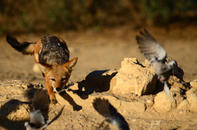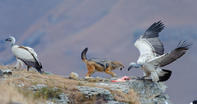Not Fussy
Jackals are extremely resourceful feeders. They are omnivores and will eat whatever is available even changing their menu seasonally.

They will even cache food to eat at a later occasion. Usually, they focus on insects and rodents but remarkably for carnivores they will eat quite a large percentage of fruit and are responsible for the naming of the Jackalberry tree whose fallen fruits they are known to relish. Jackals can be seen moving around at a bouncy trot. This is an energy efficient gait for covering ground while on patrol. They will walk slowly if seeking sensitive prey such as rodents and insects.
Scavenge and Hunt

Jackals are adept and bold scavengers. They have been known to rush in and grab meat off carcasses that still have the offending predator in attendance. Although they defend mutually exclusive territories, forays by neighbouring jackals into another’s turf for access to food such as a large carcass that needs dispatching, are tolerated.
They are however also capable hunters and using the typical canid (dog-family) technique they will leap up with an arched back to pin down quarry such as rodents or hares biting them across the back to snap the spine.
Larger prey is run down, sometimes cooperatively in a relay fashion, until the prey is exhausted. Jackals are vital ecologically for removing sick and injured animals from the bush. Jackals play an important ecological role in controlling rodent and dassie populations.
By Megan Emmett